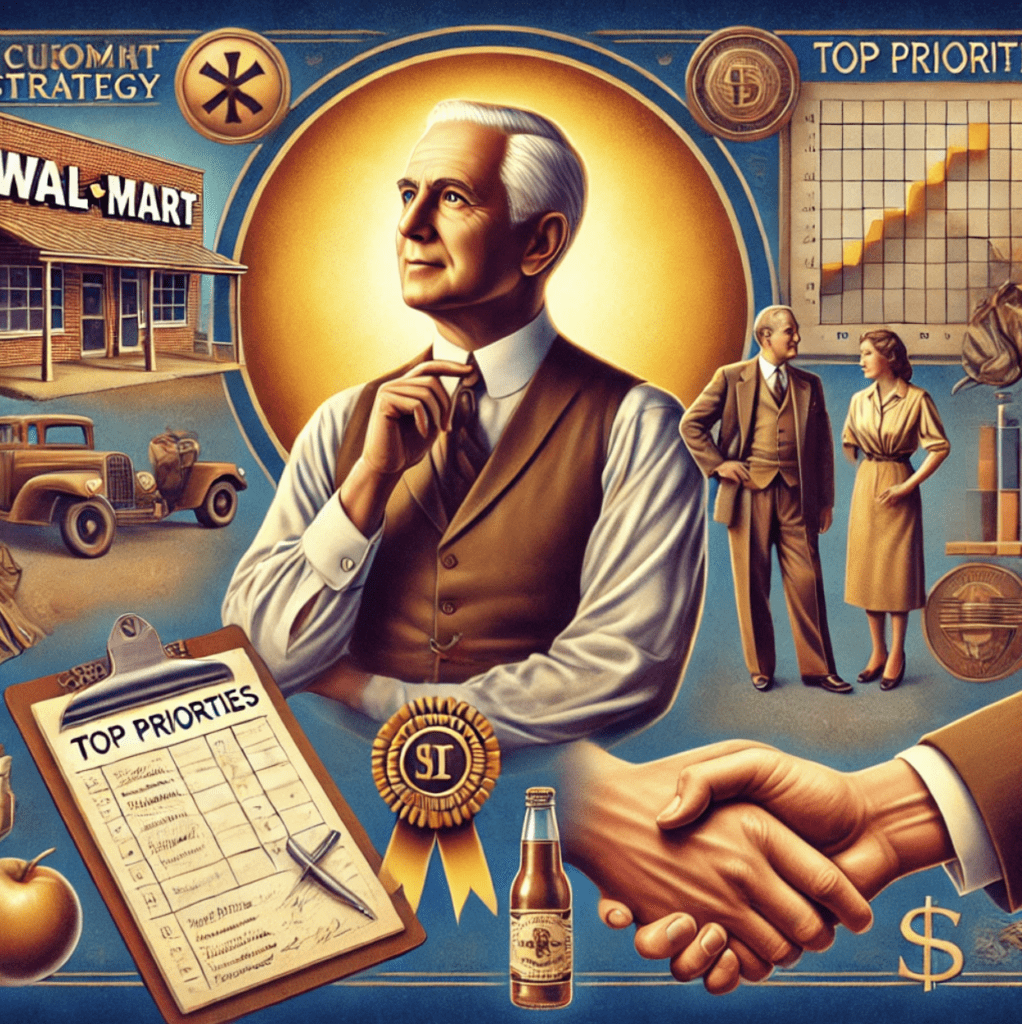Sam Walton’s journey from a young entrepreneur to the founder of one of the largest retail empires in history is a masterclass in:
- Innovation
- Strategy
- And adaptability.
His success was no overnight phenomenon.
It was the result of decades of:
- Calculated moves
- Unconventional sourcing
- Market positioning
- And relentless experimentation.
The Early Years: Building a Foundation
At the age of 27, Sam Walton took his first step into the retail world by purchasing a franchise store.
Rather than conforming to conventional business practices, he sought out offbeat suppliers and unique sources for products.
This relentless experimentation laid the groundwork for his eventual breakthrough.
For nearly two decades, he:
- Tested different strategies
- Learned from failures
- And refined his approach
until he was ready to launch something revolutionary.
At 44, Walton opened the first Wal-Mart.
But this was not just another retail store – it was an outgrowth of everything he had been doing up to that point.
- Every lesson learned
- Every failed attempt
- And every small success
contributed to a business model that would disrupt the retail industry.
Finding Opportunity in the Overlooked
One of the biggest secrets behind Wal-Mart’s success was its focus on an untapped market:
Small towns.
At the time, major retailers were setting up shop in big cities, assuming that smaller towns wouldn’t generate enough revenue.
Walton saw an opportunity where others saw limitation.
By targeting small towns that competitors ignored, Wal-Mart was able to dominate entire regions without facing intense competition.
This strategic positioning allowed the company to establish a stronghold and build a loyal customer base without the pressures of crowded urban markets.
The Art of Market Saturation
Rather than scattering stores in random locations, Walton developed a strategy known as market saturation.
Instead of opening isolated stores, Wal-Mart expanded in a structured pattern – spreading outward and then filling in gaps.
This ensured that the brand quickly became a household name in each market before moving to the next.
By clustering stores within specific areas, Wal-Mart could:
- Streamline distribution
- Minimize advertising costs
- And leverage word-of-mouth marketing.
Keeping Costs Low to Keep Prices Low
Wal-Mart’s ability to offer the lowest prices was not a gimmick – it was a calculated effort built on cost-cutting measures.
Walton believed that to maintain low prices, the company had to operate with extreme efficiency.
This meant rigorous cost control at every level:
From supply chain management to employee operations.
By keeping costs low, Wal-Mart could pass on the savings to customers, creating a strong value proposition.
This was a game-changer in retail, forcing competitors to either adapt or be left behind.
The Science of Store Sizing
One of Wal-Mart’s biggest challenges was determining what size store to place in which market.
Rather than using a one-size-fits-all approach, Walton developed five different store sizes and implemented them strategically based on market demand.
This cookie-cutter model allowed for rapid expansion while ensuring that each store was optimized for its location.
Each store was designed to fit the community it served.
A small town didn’t need a massive superstore, while larger markets could sustain larger operations.
This flexible approach maximized profitability and ensured that each store was a perfect fit for its respective market.
Prioritization Over Busywork
Despite being the head of a growing empire, Walton did not conform to a rigid, overbooked schedule.
Instead, he focused on results.
He constantly recorded ideas, prioritizing the top 10-15 tasks that would have the highest impact.
This allowed him to focus on meaningful work rather than getting bogged down by minor details.
His leadership style was based on the principle that not all tasks are created equal.
By focusing on high-leverage activities, he ensured that his time and energy were spent on initiatives that propelled the company forward.
The Power of Word-of-Mouth Marketing
In an era where companies relied heavily on traditional advertising, Wal-Mart took a different route.
Instead of pouring vast sums into marketing campaigns, the company relied on word-of-mouth.
Satisfied customers became brand ambassadors, spreading the word about Wal-Mart’s unbeatable prices and superior shopping experience.
This organic marketing approach saved money and built a sense of community around the brand.
People didn’t just shop at Wal-Mart – they felt a connection to it.
This loyalty fueled exponential growth as customers enthusiastically recommended the store to friends and family.
The People Factor: How Employees Shape Customer Experience
One of Walton’s core beliefs was that the way employees are treated directly impacts how they treat customers.
He understood that happy, motivated employees would provide better service, which in turn would create satisfied customers who would keep coming back.
Wal-Mart’s culture was built around recognizing and valuing its workforce.
From profit-sharing programs to open communication with employees, Walton fostered a work environment that encouraged loyalty and commitment.
This people-first approach wasn’t just good for morale – it was a strategic business move that reinforced the company’s reputation for quality service.
Lessons from Walton’s Playbook
Walton’s rise to success holds valuable lessons for entrepreneurs and business leaders alike.
Here are a few key takeaways from his journey:
- Experiment Relentlessly – Success doesn’t come from following the herd. Walton constantly tested new ideas, refining his approach until he found what worked.
- Find Opportunity in the Overlooked – Many of the best business opportunities exist in places others ignore. Walton’s decision to focus on small towns proved to be a game-changer.
- Expand Strategically – Growth should be intentional. Wal-Mart’s market saturation strategy ensured dominance in one area before expanding to the next.
- Prioritize What Matters – Time is a limited resource. By focusing on the most impactful tasks, Walton was able to drive massive results without unnecessary distractions.
- Keep Costs Low to Keep Prices Low – Efficiency and cost-cutting are essential for a competitive pricing advantage.
- Leverage Word-of-Mouth Over Advertising – Customers are the best marketers. Providing a great product and experience creates organic growth.
- Treat Employees Well – The way employees feel about their job translates to how they treat customers. A positive work culture fuels better service.
The Legacy of Sam Walton
Sam Walton’s principles continue to shape Wal-Mart’s operations today.
His:
- Vision
- Strategic thinking
- And ability to challenge the status quo
transformed a single store into a global empire.
His approach wasn’t just about selling products – it was about redefining how business was done.
For those looking to build their own success, Walton’s journey serves as a reminder that:
- Innovation
- Persistence
- And a deep understanding of customer needs
can turn even the most unconventional ideas into industry-defining enterprises.
You May Also Like:
How To Create Digital Assets (And Profit)
Print That Profits Review
The First Thing I Bought With Online Income (And How It Changed My Life Forever)
Deep Thoughts On Learning From Mistakes
How Extra Revenue Streams Change Your Life
How To Save Time And Achieve More (Must Read)
3 Types Of Online Business Models And Their Pros & Cons
"Is College Worth It?" Pros Vs Cons
My name is Mister Infinite. I've written 600+ articles for people who want more out of life. Within this website you will find the motivation and action steps to live a better lifestyle.

